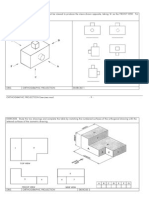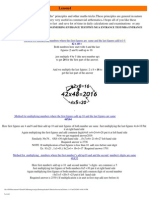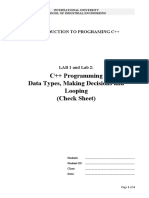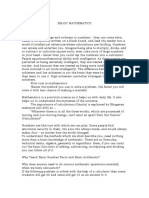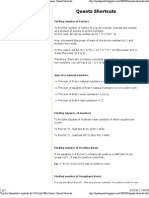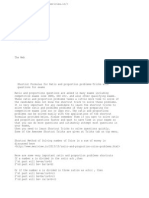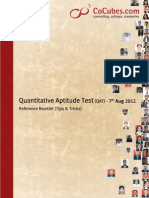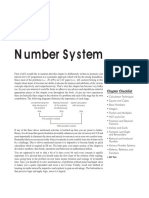CAT Exam
CAT Exam
Uploaded by
Manivannan ArjunanCopyright:
Available Formats
CAT Exam
CAT Exam
Uploaded by
Manivannan ArjunanOriginal Description:
Original Title
Copyright
Available Formats
Share this document
Did you find this document useful?
Is this content inappropriate?
Copyright:
Available Formats
CAT Exam
CAT Exam
Uploaded by
Manivannan ArjunanCopyright:
Available Formats
1
Fundamentals
16
1
LFUNDAMENTALS
ogra ith m
First of all I would like to mention that this chapter is
deliberately written to promote your interest for CAT
preparation in a systematic approach which will lay the strong
foundation. Since this chapter subsumes fundamentals of
calculation techniques along with various number systems
besides basic tenets of maths, hence it is named as
Fundamentals. Again since most of the problems (i.e.,
2040%) in CAT paper (viz., QA section) belong to this
chapter alone hence it becomes inevitable to discuss the
nuances and subtleties of the various concepts objectively and
comprehensively. Thats why this chapter has become very
bulky too.
In your own interest it would be better to adhere to my
advices and stipulations stated at appropriate places in this
chapter even throughout the book. As per my own experiences
there are basically three stages in the solution of a problem and
each of the stage has its own contribution. The following
diagrams illustrates the importance of each stage.
Making flowchart Speed calculation
Comprehending the
with accuracy
of the solution
idea-structure of
simultaneously
the problem
40%
30%
30%
70% problem solved
100% problem solved
If any of the three above mentioned activities is botched
up then you are prone to failure. Hence, it is obvious that speed
calculation invariably enhances your rate of success in CAT
and most importantly it eliminates the stress and anxiety to
ensconce you in your own comfort zone. Remember that you
can succeed only when you operate in your comfort zone else it
turns out to be a challenge. Due to above mentioned reasons it
is imperative to become handy in quick calcualtion which is
required in DI too.
The latter part, even major section, of the chapter is
devoted to numbers, their kinds, operations and behaviour in
mathematical milieu. You are supposed to not to skip a bit of it
since every bit and every concept is equally important. It is
advised that you should make the flow chart of the solution
while reading, since going back to the problem several times
means irritation and wastage of invaluable time. Also, you
should try to solve maximum no. of problems without pencil
and paper since it makes you quick respondent and saves a lot
of time. Finally, avoid rote method of learning in maths instead
be inqusitive and explorer to gain an advantage. The
bottomline is that perceive logic and apply logic, since it is
logical.
CALCULATION TECHNIQUES
Multiplication : Multiplication is nothing but the
shortest method of addition. In day-to-day life when we have to
add up the same quantity many a times, so we multiply the
given number by the number of times to which the given
number is to be added repeatedly e. g., 3 + 3 + 3 + 3 + 3 + 3 + 3
can be added seven times but to get quick result we just
multiply 3 by 7. Hence, we get 3 7 = 21. Thus, I am sure that
now you must have become aware of that how much important
is the multiplication table. So I hope that you will learn the
multiplication table.
Now, I would like to suggest you that in the competitive
exams like CAT, where speed and accuracy are totally
indispensable. So there are some novel and enticing techniques
for multiplication given in this chapter. But in some techniques
you have to know the square of some relevent numbers,
normally the squares of 1 to 100. Last but not the least you
dont need to bother about since I have some very innovative
techniques to learn and calculate the squares very readily. Even
most of the times you need not to use a pencil and paper for this
work and thats my purpose.
Basically we divide these techniques into two categories.
The first one which I have derived from some algebraic
operations and the second one belongs to our ancient maths i. e.,
Vedic maths.
In this book I have laid emphasis on my own approach of
multiplication, because years of research in numeric maths I
have found that I myself and my students find it comfortable as
it is very convenient and pragmatic to do within a few seconds.
Fundamentals
Case 1.
= 287 20 287
= 287 2 10 287
= 574 10 287
= 5740 287 = 5453
Multiplication by 5, 25 ( = 5 ), 125 ( = 5 ),
2
625 ( = 5 ) etc.
4
EXAMPLE 1 Multiply 187 by 5 i.e., 187 5.
Step 1: Associate as many zeros at the end of the
given number as there is the power to 5. Thus we write 187 as 1870.
(because 5 = 51)
Step 2: Divide the resultant number by 2 as many times as
there is the power to 5.
1870
Thus,
= 935
2
SOLUTION
EXAMPLE 2 Multiply 369 by 125.
SOLUTION
Step 1:
SOLUTION 743 99 = 743 (100 1)
= 74300 743 = 73557
EXAMPLE 2 Multiply 23857 by 9999.
SOLUTION
369000 (Q 125 = 5 ) hence 3 zeros will be
23857 9999 = 23857 (10000 1)
= 238570000 23857 = 238546143
NOTE
Step 2:
Case 2. Multiplication of a number by 9 n i. e., 9,
9 2 ( = 81), 9 3 ( = 729) etc.
EXAMPLE 1 Multiply 238 by 9.
e . g., K 9999 n
= (K 0000 n zeros) K
Case 5. To multiply those two numbers, the sum of
whose unit digit is 10 and the rest digits (left to the unit digit)
are same in both the numbers.
EXAMPLE 1 Multiply 38 by 32.
Step 1: Multiply the unit digits as 8 2 = 16
Step 2: Add 1 to the left digits then multiply this increased
number by the original digits i . e. ,
3 (3 + 1) = 12
Thus, we get
38 32 = 1216
SOLUTION
EXAMPLE 2 Multiply 83 by 87.
Step 1:
3 7 = 21
Step 2:
8 (8 + 1) = 72
83 87 = 7221
SOLUTION
Multiply the given number by 10 and then subtract
the given number from the resultant number. So
238 9 = 238 (10 1)
= 2380 238 = 2142
[using distributive law as a (b c) = ab ac]
SOLUTION
EXAMPLE 2 Multiply 238 by 81.
Step 1: 238 81 = 238 9 9
2: 238 (10 1) (10 1)
3: [ 2380 238] (10 1)
4: 2142 (10 1)
5: 21420 2142 = 19278
EXAMPLE 3 Multiply 71 by 79.
Step 1:
9 1 = 09
Step 2:
7 (7 + 1) = 56
71 79 = 5609
SOLUTION
NOTE
The last two places are reserved for the product of unit digits as
in the above example 1 9 = 9 but we fill the last two places by
writing 09. So dont write 569 since it is wrong.
EXAMPLE 4 Multiply 125 by 125.
Step 1:
Step 2:
So,
SOLUTION
i . e .,
NOTE
K
n
369000 369000
=
= 46125
2 2 2
8
(Since, there is 53 hence it will be divided by 23.)
In general, if you want to multiply any number K by 5n then
you just need to divide that number by 2n, after writing or
(associating) n zeros at the end of the number i . e. ,
K 0000 n zeros
K 5n =
2n
732000000
e. g. ,
732 56 =
2 2 2 2 2 2
732000000
=
= 11437500
64
Step
Step
Step
Step
EXAMPLE 1 Multiply 743 by 99.
associated.
SOLUTION
Case 4. Multiplication of a number by the number
which contains all the digits as 9.
Case 3. Multiplication of a number by the numbers
whose unit (i. e., last) digit is 9.
5 5 = 25
12 (12 + 1) = 156
125 125 = 15625
EXAMPLE 5 Multiply 431 by 439.
Step 1:
1 9 = 09
Step 2:
43 (43 + 1) = 1892
So,
431 439 = 189209
SOLUTION
EXAMPLE 1 Multiply 287 by 19.
SOLUTION
287 (10 + 9) = 287 10 + 287 9
= 2870 + 287 (10 1)
= 2870 + 2870 287
= 5740 287 = 5453
or
287 19 = 287 (20 1)
EXAMPLE 6 Multiply 1203 by 1207.
Step 1:
3 7 = 21
Step 2:
120 (120 + 1) = 14520
SOLUTION
Fundamentals
1203 1207 = 1452021
So,
NOTE
N1
N2
N1
N 2 2d
N 1 N 2 = (N 1 + d ) 2 d 2
Case 6. To multiply the two numbers whose difference
is always an even number.
i . e .,
N 1 N 2 = (N 2 d ) 2 d 2
EXAMPLE 1 Multiply 38 by 52.
Step 1: 52 38 = 14 (here 14 is an even number)
14
Step 2:
Step 3: 38 + 7 or 52 7 = 45
=7
2
Step 4: (45)2 = 2025
Step 5: 7 2 = 49
SOLUTION
Step 6: 2025 49 = 1976
Step 1: 96 76 = 20 (here 20 is an even number)
20
Step 2:
= 10
2
Step 3: 76 + 10 = 96 10 = 86
Step 4: (86)2 = 7396
SOLUTION
Step 1: 215 185 = 30
(here 30 is an even number)
30
Step 2:
= 15
2
Step 3: 185 + 15 = 215 15 = 200
Step 4: (200)2 (15)2 = 40000 225 = 39775
SOLUTION
VEDIC METHODS OF MULTIPLICATION
23
EXAMPLE 1 74
Solve 23 74.
4 3 = 12
2
SOLUTION
23
74
1702
(4 2 + 7 3) + 1
= 30
(7 2) + 3
= 17
83
EXAMPLE 2 65
Solve 83 65.
5 3 = 15
5
SOLUTION
83
65
95
83
65
5395
To multiply any two numbers say, N1 and N 2 we
apply the following methods.
SHORTCUT
N N1
N + N2
N1 N 2 = 1
2
2
Step 6: 7396 100 = 7296
EXAMPLE 3 Multiply 185 by 215.
23
74
02
Step 1: 22 17 = 5
5
Step 2:
= 2.5
2
Step 3: 17 + 2.5 = 22 2.5 = 19.5
Step 4: (19.5)2 (2.5)2 = 380.25 6.25 = 374.00
SOLUTION
EXAMPLE 2 Multiply 76 by 96.
Step 5: (10)2 = 100
EXAMPLE 1 Multiply 17 by 22.
(5 8 + 6 3) + 1
= 59
(6 8) + 5
= 53
23
74
2
2 3
7 4
02
23
74
1702
12
29 + 1 = 30
So, if you know the square of the required numbers then
using this method you can multiply any two number within 2-3
seconds as
2
64 56
56 + 64
56 64 =
2
2
524
19
6
524
19
9956
3456
89
4
6 5
95
83
58 + 1 = 59
65
5395
48 + 5
524
9 4 = 36
EXAMPLE 3 Solve 524 19.
524
SOLUTION 19
(9 2 + 1 4) + 3
56
= 25
524
19
(9 5 + 1 2) + 2
956
= 49
83
15
= (60)2 (4)2 = 3600 16 = 3584
14 + 3
65
5
8 3
3456
89
84
3456
89
307584
524
19
524
3456
9 6 = 54
89
34 5 6
(9 5 + 8 6) + 5
(9 4 + 8 5) + 9
= 85
3456
89
7584
19
19
= 98
3456
89
584
524
(1 5) + 4
=9
EXAMPLE
Evaluate
19
89
34 5 6
89
3456
89
(9 3 + 8 4) + 8
= 67
3456
89
83+6
= 30
Fundamentals
3456 89.
SOLUTION
245
367
5
245
367
15
245
367
915
245
367
9915
245
5 7 = 35
367
245
(7 4 + 6 5) + 3
= 61
(7 2 + 6 4 + 3 5 ) + 6
= 59
367
245
367
245
367
(6 2 + 3 4) + 5
= 29
245
367
(3 2) + 2
EXAMPLE 89915
5 Evaluate 245 367.
=8
245
367
4567
1289
3 9 7 = 63
4567
1289
63 (9 6 + 8 7) + 6 = 116
4567
1289
863 (9 5 + 8 6 + 2 7) + 11 = 118
4567
EXAMPLE 61289
Evaluate 123456 789.
6863 (9 4 + 8 5 + 2 6 + 1 7) + 11 = 106
SOLUTION
4567
1289
(8
4 + of
2 4567
5 +11289.
6) + 10 = 58
EXAMPLE86863
7 Find the
value
4567
SOLUTION1289
886863 (2 4 + 1 5) + 5 = 18
4567
1289
5886863 (4 1) + 1
SOLUTION
123456
789
4
123456
789
84
123456
789
784
123456
789
6784
123456
789
06784
123456
789
406784
123456
789
7406784
123456
789
97406784
123456
9 6 = 54
789
123456
(9 5 + 8 6) + 5 = 98
789
123456
(9 4 + 8 5 + 7 6) + 9 = 127
789
123456
(9 3 + 8 4 + 7 5) + 12 = 106
789
123456
(9 2 + 8 3 + 7 4) + 10 = 80
789
123456
(9 1 + 8 2 + 7 3) + 8 = 54
789
123456
(8 1 + 7 2) + 5 = 27
789
123456
(7 1) + 2 = 9
Divisor Dividend Quotient
xyz
Remainder
789
325768
1234
2 4 8 = 32
325768
1234
12 (4 6 + 3 8) + 3 = 51
325768
1234
712 (4 7 + 3 6 + 2 8) + 5 = 67
325768
1234
7712 (4 5 + 3 7 + 2 6 + 1 8) + 6 = 67
325768
1234
Find the value of 325768 1234.
EXAMPLE 8
97712 (4 2 + 3 5 + 2 7 + 1 6) + 6 = 49
SOLUTION
325768
1234
997772 (4 3 + 3 2 + 2 5 + 1 7) + 4 = 39
325768
1234
1997712 (3 3 + 2 2 + 1 5) + 3 = 21
325768
1234
01997712 (2 3 + 1 2) + 2 = 10
325768
1234
401997712 (1 3) + 1 = 4
Fundamentals
DIVISIBILITY RULES
While solving the mathematical problems we need to
divide one number by another number. In general we use four
terms for this process as
or
Dividend = (Divisor Quotient) + Remainder
for example
30 = ( 7 4) + 2
where quotient is a whole number i. e., 0, 1, 2, 3, etc
and remainder is always less than divisor or zero.
6 234 39
18
54
54
So, when the remainder is zero, we can say that the given
number is divisible by the particular divisor number.
4
(decimal notation)
Now,
238 6 = 39 = 39.66
6
Since the above number when divided by 6 leaves a
remainder of 4 then it is said to be not divisible by 6 where 238
is dividend, 39 is quotient obtained when divided by 6 as a
40
divisor. Thus we get 4 as
remainder.
6 a 240
Further if we subtract240
the remainder from the dividend
then the dividend (the resultant number) becomes divisible by
particular divisor. e. g.,
238 4 = 234
(dividendremainder)
Here, the remainder is zero and the number is perfectly
divisible by 6.
Another point is that if we add the difference of divisor
and remainder to the given number (i. e., dividend) the number
becomes divisible by that particular divisor. e. g.,
(DivisorRemainder)
6 4=2
238 + 2 = 240
Thus (238 + 2) becomes perfectly divisible by the
particular divisor.
For negative integers
e. g., 37 5
37 3 + 3 40 + 3 40 3
=
=
+
5
5
5
5
Here 8 is quotient and 3 is remainder.
NOTE
Rule 1. If a number N is divisible by D then the product
of N with any other integral number K is also divisible by D.
NK
N
Remainder 0
Remainder 0
i. e.,
D
D
Rule 2. If N 1 and N 2 two different numbers are
divisible by D individually then their sum (i. e., N 1 + N 2 ) and
their difference ( N 1 N 2 ) is also divisible by D.
Rule 3. If a number N 1 is divisible by N 2 and N 2 is
divisible by N 3 then N 1 must be divisible by N 3 .
Rule 4. If two numbers N 1 and N 2 are such that they
divide mutually each other it means they are same i. e.,
N 1 = N 2 only.
HOW TO CHECK THE DIVISIBILITY
We have certain rules to check the divisibility by certain
integral numbers. With the help of the following rules it has
become easier to know whether a certain number is divisible or
not by a particular number without actually dividing the number.
Divisibility by 2
Any integral number whose last digit (i. e., unit digit)is
even or in other words the unit digit is divisible by 2. It means
any number whose last digit is either 0, 2, 4, 6 or 8, then this
number must be divisible by 2.
e. g., 395672, 132, 790, 377754, etc.
Divisibility by 4
If the number formed by last two digits of the given
number is divisible by 4 then the actual number must be
divisible by 4. i. e., the last two digits of a number can be 00, 04,
08, 12, 16, 20, 24, 28, 32, , 96.
e. g., 33932, 7958956, 2300, 1996, 3819764280 etc.
Divisibility by 8
If the number formed by last three digits of the given
number is divisible by 8 then the actual number must be
divisible by 8 i. e., the last three digits of the divisible number
can be 000, 008, 016, 024, 032, 040, , 096, 104, , 992.
e. g., 8537000, 9317640, 3945080, 23456008, 12345728,
3152408 etc.
Divisibility by 16
If the number formed by last four digits of the given
number is divisible by 16 then the actual number must be
divisible by 16 i. e., the last 4 digits of the divisible number can
be 0000, 0016, 0032, 0048, 0064, 0080, 0096, 0112, 0128,
0144, 0160, , 0960, 0976, , 0992, , 1600, , 9984.
Divisibility by 32, 64, 128, can be checked just by
checking the last 5, 6, 7, digits number formed from the
given number as in the above cases.
Divisibility by 3
If the sum of the digits of the given number is divisible by
3 then the actual number will also be divisible by 3.
e. g., 12375 is divisible by 3 since the sum of digits
1 + 2 + 3 + 7 + 5 = 18 is divisible by 3.
Similarly 63089154 is also divisible by 3 since the sum of
its digits 6 + 3 + 0 + 8 + 9 + 1 + 5 + 4 = 36 is divisible by 3.
Divisibility by 9
If the sum of the digits of the given number is divisible by
9 then the actual number will also be divisible by 9.
e. g., 7329753 is divisible by 9, since
7 + 3 + 2 + 9 + 7 + 5 + 3 = 36 is divisible by 9.
Similarly the divisibility by 27, 81, 243, can be
checked.
Divisibility by 5
A number is divisible by 5 if and only if the last (i. e., unit)
Fundamentals
digit is either 0 or 5.
e. g., 5, 10, 15, 20, 25, 30, 35, , 275, 365, , 995, 70000,
438915 etc.
Divisibility by some special numbers e . g., 7, 11, 13, 17,
19, 23, etc.
Why are these numbers treated differently for checking
the divisibility? Since, if we multiply these numbers by any
other number (except 10 or multiples of 10) these numbers can
never be divisible by 10. So to make the process easier we
bring the given number (i. e., divisor) closer to the multiples of
10 with the difference of 1 (e. g., 9 or 11, 19 or 21, 29 or 31, 39
or 41 etc).
Now if the number is one less than the multiples of 10
( i. e., 9, 19, 29, 39, ) we need to increase it by 1 to make it
further multiple of 10. Hence we call it one more osculator
and the value of multiple of 10 is called the value of one
more osculator.
Similarly if the number is one more than the multiple of
10 (i. e., 11, 21, 31, 41, , etc) we need to decrease it by 1 to
make it the multiple of 10. So we call it negative osculator
and the value of multiple of 10 is the value of negative
osculator.
e. g., The given number is 7 (divisor number) then we
bring it closer to the multiple of 10 with the difference of 1,
then
7 3 = 21 = 20 + 1
20 = 21 1 = (2 10)
(1)
Now in the above expression 2 is the multiple of 10 and is
known as the negative osculator for 7.
Now let us consider the next example of 13 and then
bring it closer to the multiples of 10 with a difference of 1. Thus
13 3 = 39
39 + 1 = 40 = ( 4 10)
and
(2)
In the above expression 4 is the multiple of 10 and 4 is the
value of one more osculator.
Similarly for 17 we can find the osculator as
17 3 = 51 = 50 + 1
50 = 51 1 = (5 10)
So,
Here 5 is the negative osculator for 17.
Similarly for 31 the osculator is negative and the value of
negative osculator is 3.
Q
31 = 30 + 1
30 = 31 1 (3 10)
Now we will apply the osculator techniques to check the
divisibility by 7, 11, 13, 17, 19, etc.
Divisibility by 7
To check the divisibility of a number by 7 we apply the
following method. Let the number be 133.
Step 1. 133 13 3 2 = 13 6 = 7
Since 7 is divisible by 7, so the given number 133 will
also be divisible by 7.
In the above process 2 is multiplied with the last digit is
the negative osculator for 7, which I have earlier discussed.
EXAMPLE 1 Check whether 1071 is divisible by 7.
Step 1. 1071 107 1 2 = 105
Step 2. 105 10 5 2 = 0
Since 0 is divisible by 7 hence the given number 1071 is also
divisible by 7.
SOLUTION
EXAMPLE 2 Check whether 939715 is divisible by 7.
SOLUTION
Step 1.
939715 93971 5 2 = 93961
Step 2. 93961 9396 1 2 = 9394
Step 3. 9394 939 4 2 = 931
Step 4. 931 93 1 2 = 91
Step 5. 91 9 1 2 = 7
Hence, it is divisible by 7.
NOTE 1.
Divisibility by 13
EXAMPLE 1.
SOLUTION
Check whether 2366 is divisible by 13.
Step 1. 2366 236 + 6 4 = 260
[Since, the osculator for 13 is 4 and it is one more osculator.
So we use addition]
Step 2. 260 26 + 0 4 = 26
Since 26 (or 260) is divisible by 13 hence 2366 is also
divisible by 13.
EXAMPLE 2.
SOLUTION
Check whether 377910 is divisible by 13.
Step 1. 377910 37791 + 0 4 = 37791
Step 2. 37791 3779 + 1 4 = 3783
Step 3. 3783 378 + 3 4 = 390
Step 4. 390 39 + 0 4 = 39
Since 39 is divisible by 39. So 377910 is also divisible by 13.
Fundamentals
Divisibility by 17
EXAMPLE 1
SOLUTION
Find out whether 323 is divisible by 17.
Step 1. 32 3 32 3 5 = 17
[Q 5 is the negative osculator of 17]
Therefore 323 is divisible by 17.
EXAMPLE 2
SOLUTION
Checkout that 12716 is divisible by 17 or not.
Step 1. 1271 6 1271 6 5 = 1241
1241 1 124 1 5 = 119
119 11 9 5 = 34
so we can conclude that 12716 is divisible by 17. Since 34
and 119 both are simply visible that these two numbers are divisible
by 17.
As I have already mentioned that you can stop your checking
process as soon as you can get a number which is easy to know that
the particular number is divisible by the given divisor or not.
Further you should know that every resultant value in the right
hand side might be divisible by the divisor whether you readily
recognise it or not.
SOLUTION
Divisibility by 11
A number is divisible by 11if the difference between the
sum of the digits at odd places and sum of the digits at even
places is equal to zero or multiple of 11 (i.e., 11, 22, 33 etc.)
For example : 57945822
Here sum of the digits at odd places = 2 + 8 + 4 + 7 = 21
and sum of the digits at even places = 2 + 5 + 9 + 5 = 21
and thus the difference = 0 ( = 21 21)
Hence 57945822 is divisible by 11.
Divisibility by Composite Numbers e.g., 4, 6, 8, 10, 12,
14, 15 etc.
Divisibility by 6
A number is divisible by 6 only when it is divisible by 2
and 3 both. So first of all we see that the number is even or not
then we check for the divisibility by 3.
Divisibility by 10
Divisibility by 19
EXAMPLE 1
Step 2. 12 103 = 91
Since 91 is divisible by 13 hence 12478375 is also divisible
by 13.
Find out whether 21793 is divisible by 19.
Step 1. 2179 3 2179 + 3 2 = 2185
[Q 2 is the one more osculator of 19]
Step 2. 218 5 218 + 5 2 = 228
A number is divisible by 10 if and only if when it is
divisible by both 2 and 5. So it can be easily observed that a
number is divisible by 10 must ends up with zero(s) at the right
end (i.e., last digits) of itself.
NOTE
n
10n
Step 3. 22 8 22 + 8 2 = 38
Hence 21793 is divisible by 19.
Shortcut rule for the divisibility by 7, 11 and 13 : A
number can be divisible by 7, 11 or 13 if and only if the difference of
the number formed by the last three digits and the number formed
by the rest digits is divisible by 7, 11 or 13 respectively.
For example we have to check that 139125 is divisible by 7 or
not.
So we take the difference as given below
139 125 = 14
Since, the difference is divisible by 7. Hence the given
number is also divisible by 7.
EXAMPLE 1
SOLUTION
Check whether 12478375 is divisible by 13 or not.
Divisibility by 12
A number is divisible by 12 only when it is divisible by 4
and 3 both at the same time. So first of all check the divisibility
by 4 then by 3
Divisibility by 15
A number is divisible by 15 only when it is divisible by 3
and 5 both simultaneously. So first of all check the number by 5
then by 3.
Thus we can conclude that any number which is divisible
by a composite number, as mentioned above, must be divisible
by all its factors whose L.C.M. is the given divisor.
Step 1. 12478 375 = 12103
1. What is the largest possible two digit number by which
2179782 can be divided ?
(a) 88
(b) 50
(c) 66
(d) 99
2. At least which number must be subtracted from
9999999 so that it will become the multiple of 125?
(a) 124
(b) 4
(c) 24
(d) none of these
3. A number of the form10 n 1 is always divisible by 11 for
every n is a natural number, when :
(a) n is odd
(c) n is even
(b) n is prime
(d) cant say
4. Out of the following numbers which is divisible by 132?
(a) 31218
(b) 78520
(c) 38148
(d) 52020
5. If 653xy is divisible by 80 then the value of x + y is :
(a) 2
(c) 4
(b) 3
(d) 6
6. The value of k if k35624 is divisible by 11 :
Fundamentals
(a) 2
(c) 7
(b) 5
(d) 6
7. If 42573k is divisible by 72 then the value of k is :
(a) 4
(b) 5
(c) 6
(d) 7
8. How many numbers between 1 and 1000 are divisible
by 7?
(a) 777
(b) 142
(c) 143
(d) none of these
9. How many numbers between 55 and 555 including both
the extreme values are divisible by 5?
(a) 100
(b) 111
(c) 101
(d) none of these
10. How many numbers are there from 100 to 200 ?
(a) 100
(b) 101
(c) 99
(d) none of these
11. How many numbers are divisible by 3 in the set of
numbers 300, 301, 302, ..., 499, 500?
(a) 200
(b) 66
(c) 67
(d) none of these
12. How many numbers are there between 200 and 800
which are divisible by both 5 and 7?
(a) 35
(b) 16
(c) 17
(d) cant be determined
13. In the above question total numbers in the set of numbers
S = {200 , 201, ... , 800 } which are either divisible by 5 or
by 7 is :
(a) 210
(b) 190
(c) 199
(d) cant be determined
14. How many numbers are there in the set
S = {200 , 201, 202 , ... , 800 } which are divisible by
neither of 5 or 7?
(a) 411
(b) 412
(c) 410
(d) none of these
15. Total number of numbers lying in the range of 1331 and
3113 which are neither divisible by 2, 3 or 5 is :
(a) 477
(b) 594
(c) 653
(d) none of these
16. Atleast what number must be subtracted from 434079
so that it becomes divisible by 137 ?
(a) 173
(b) 63
(c) 97
(d) cant be determined
17. In the above question, at least what number be added to
434079, so that it will become divisible by (or multiple of)
137 ?
(a) 97
(b) 74
(c) 75
(d) none of these
18. Which one number is closest to 193 which is divisible by
18 is :
(a) 180
(b) 195
(c) 198
(d) 108
19. The product of two numbers ab7 and cd5 could be, where
ab7 and cd5 are individually three digit numbers :
(a) 8135
(b) 79236
(c) 8735255
(d) none of these
20. When a 3 digit number 984 is added to another 3 digit
number 4 p3, we get a four digit number 13q7, which is
divisible by 11. The value of p + q is :
(a) 10
(b) 11
(c) 12
(d) 13
21. When a number divided by 9235, we get the quotient
888 and the remainder 222, such a least possible
number is :
(a) 820090
(b) 8200920
(c) 8200680
(d) none of these
22. The number which when divided by 33 is perfectly
divisible and closer to 1000 is :
(a) 990
(b) 999
(c) 1023
(d) cant be determined
23. A number which when divided by 32 leaves a remainder
of 29. If this number is divided by 8 the remainder will
be :
(a) 0
(b) 1
(c) 5
(d) 3
24. A number when divided by 5 leaves a remainder of 4,
when the double (i.e., twice) of that number is divided by
5 the remainder will be :
(a) 0
(b) 1
(c) 3
(d) cant be determined
25. When a number N is divided by a proper divisor D then it
leaves a remainder of 14 and if the thrice of that number
i.e., 3N is divided by the same divisor D, the remainder
comes out to be 8. Again if the 4 times of the same number
i.e., 4N is divided by D the remainder will be :
(a) 35
(b) 22
(c) 5
(d) cant be determined
26. A number when divided by 5 gives a number which is 8
more than the remainder obtained on dividing the same
number by 34. Such a least possible number is :
(a) 175
(b) 75
(c) 680
(d) does not exist
27. When a natural number divided by a certain divisor, we
get 15 as a remainder. But when the 10 times of the
same number is divided by the same divisor we get 6 as
a remainder. The maximum possible number of such
divisors is :
(a) 6
(b) 7
(c) 15
(d) cant be determined
28. A certain number C when divided by N1 it leaves a
remainder of 13 and when it is divided by N2 it leaves a
remainder of 1, where N1 and N2 are the positive
N
5
integers. Then the value of N1 + N2 is, if 1 = :
N2 4
(a)
(b)
(c)
(d)
36
27
54
cant be determined uniquely
29. In the above problem the value of c is :
(a) 50 < c < 100
(b) any multiplied 11
(c) 20 < c < 50
(d) cant be determined
Fundamentals
30. In how many parts a rod of length 19.5 m can be broken
1
2
3
4
5
6
7
8
9
10
11
12
13
14
15
16
17
18
19
20
1
4
9
16
25
36
49
64
81
100
121
144
169
196
225
256
289
324
361
400
21
22
23
24
25
26
27
28
29
30
31
32
33
34
35
36
37
38
39
40
441
484
529
576
625
676
729
784
841
900
961
1024
1089
1156
1225
1296
1369
1444
1521
1600
41
42
43
44
45
46
47
48
49
50
51
52
53
54
55
56
57
58
59
60
(a) 4086
1681
1764
1849
1936
2025
2116
2209
2304
2401
2500
2601
2704
2809
2916
3025
3136
3249
3364
3481
3600
(c) 4386
of equal length of 65 cm?
(a) 20
(b) 30
(c) 3
(d) 130
31. A six digit number which is consisting of only one digits
either 1, 2, 3, 4, 5, 6, 7, 8 or 9, e.g., 111111,
222222... etc. This number is always divisible by :
(a) 7
(b) 11
(c) 13
(d) all of these
32. The maximum possible difference between the 4 digit
numbers formed by using the 4 different digits 1, 2, 3, 5
is :
(b) 5076
61
62
63
64
65
66
67
68
69
70
71
72
73
74
75
76
77
78
79
80
3721
3844
3969
4096
4225
4356
4489
4624
4761
4900
5041
5184
5329
5476
5625
5776
5929
6084
6241
6400
81
82
83
84
85
86
87
88
89
90
91
92
93
94
95
96
97
98
99
100
6561
6724
6889
7056
7225
7396
7569
7744
7921
8100
8281
8464
8649
8836
9025
9216
9409
9604
9801
10,000
(d) 3242
33. The sum of all digits except the unity that can be
substituted at the place of k inorder to be divisible by 8 in
the number 23487k 2 :
(a) 5
(b) 14
(c) 9
(d) none of these
34. A certain number N when multiplied by 13, the resultant
values consists entirely of sevens. The value of N is :
(a) 123459
(b) 58829
(c) 59829
(d) none of these
SQUARE TABLE
SQUARING
Dear students the importance of squaring of numbers is
somewhat crucial particularly in the context of CAT. I think
that initially you may not consider the importance of squaring
but later on you have to delve deep into the basics of the
squaring because most of the calculative problems can be
solved easily if you learn the squares just upto 100. Get
surprised! No there will be no any difficulty in learning these
squares, since I have some breakthrough techniques to find the
square of any number faster than any one and I can consider
that you will find no where these methods and their efficacy as
in this book. Now we will proceed step by step toward our
learning goal. Last but not the least you will consciously
observe the square table you will find some peculiarities,as
these peculiarities of the numbers (i.e., their distinct nature)
help us in remembering for long time and making a network
with other numbers.
1. Square of the numbers whose unit (i.e., last) digit is
zero (0) : Any number whose last digit is zero, we double the
number of zeros at the right side of the number and in the left of
there zeros we write the square of the non-zero numbers (or rest
digits) which is in the left of the zero(s)
e.g., square of 40 :
Step 1. 00
( 40) 2
Step 2. 4 2 = 16
Step 3. 1600
Similarly square of 700 :
Step 1. 0000
( 700) 2
Step 2. ( 7) 2 = 49
Step 3. 490000
Square of 13000 :
(13000) 2 Step 1. 000000
Step 2. (13) 2 = 169
Step 3. 169000000
Square of 21000 :
10
Fundamentals
= 16900 + 261 =17161
(21000) Step 1. 000000
2
Step 2. (21) = 441
Step 3. 441000000
2. Square of the numbers whose unit digit is 5 : Any
number whose unit digit is 5. We write 25 in the rightmost in
place of 5, then we multiply the rest (left digits to the 5 of
original number) number with its successive number (i,e, one
more than the previous one)
For example : (i) The square of 35 :
Step 1. 25
(35) 2
Step 2. 3 (3 + 1) = 12
Step 3. 1225
(ii) The square of 65 :
Step 1. 25
(65) 2
Step 2. 6 (6 + 1) = 42
Step 3. 4225
(iii) The square of 75 :
Step 1. 25
( 75) 2
Step 2. 7 ( 7 + 1) = 56
Step 3. 5625
(iv) The square of 125 :
Step 1. 25
(125) 2
Step 2. 12 (12 + 1) = 156
Step 3. 15625
(v) The square of 1405
Step 1. 25
Step 2. 140 (140 + 1) = 19740
Step 3. 1974025
(vi) The square of 139005
(139005) 2 Step 1. 25
Step 2. 13900 (13900 + 1) = 193223900
Step 3. 19322390025
(vii) The square of 155 :
Step 1. 25
(155) 2
Step 2. 15 (15 + 1) = 240
Step 3. 24025
3. (i) Square of the numbers ending with the digit 1 :
These numbers are very easy to solve. To get the square of any
such number just write the square of the previous number and
then add the previous number and the number whose square is
being asked.
For example the square of 21
2
(21) 2 = (20) 2 + (20 + 21) = 441
and
= 22500 + 301 = 22801
and
and
( 41) = ( 40) + ( 40 + 41) =1681
and
(81) 2 = (80) 2 + (80 + 81) = 6561
and
(131) = (130) + (130 + 131)
2
(1111) = (1110) 2 + (1110 + 1111)
2
= (1110) 2 + 2221
= 1232100 + 2221 =1234321
(ii) Square of the numbers whose unit digit is 9 : It is
very similar to the previous case. The difference is that here we
have to subtract instead of addition. For example the square
of 39
(39) 2 = ( 40) 2 (39 + 40)
= 1600 79 = 1521
Similarly, ( 49) = (50) 2 ( 49 + 50)
2
= 2500 99 = 2401
and
(89) = (90) 2 (89 + 90)
2
= 8100 179 = 7921
and
(139) = (140) 2 (139 + 140)
and
(249) = (250) 2 (249 + 250)
= 19600 279 = 19321
2
= 62500 499 = 62001
NOTE
(iii) Square of the numbers whose last digit is 2 or 8 :
For example (52) 2 = (50) 2 + 2 (50 + 52)
= 2500 + 204 = 2704
Similarly, (112) = (110) 2 + 2(110 + 112)
2
= 12100 + 444 =12544
and
(38) = ( 40) 2 2 (38 + 40)
and
(88) = (90) 2 2 (88 + 90)
= 1600 156 =1444
2
= 8100 356 = 7744
(iv) Square of the numbers whose unit digit is 3 or 7 :
For example : (23) 2 = (20) 2 + 3 (20 + 23)
= 400 + 129 = 529
Similarly,
(53) 2 = (50) 2 + 3 (50 + 53)
= 2500 + 309 = 2809
and
(123) = (120) 2 + 3 (120 + 123)
and
( 47) = (50) 2 3( 47 + 50)
Similarly, (31) 2 = (30) 2 + (30 + 31) = 961
2
(151) 2 = (150) 2 + (150 + 151)
= 14400 + 729 =15129
2
= 2500 291 = 2209
and
(137) = (140) 2 3 (137 + 140)
2
11
Fundamentals
= 19600 831 =18769
(2347) = (2350) 3 (2347 + 2350)
2
and
= 5522500 4691 = 5517809
(v) Square of the numbers which ends with 4 or 6 :
For example : (34) 2 = (30) 2 + 4(30 + 34)
= 900 + 256 =1156
e.g.,
(34) = (35) 2 (34 + 35)
2
or
(36) 2 = (35) 2 + (35 + 36)
Similarly,
= 1225 + 71 =1296
e.g.,
(126) = (125) 2 + (125 + 126)
2
= 15625 + 251 =15876
In general square of any number can be found by using
the square of any convenient number as base square e.g., the
numbers whose unit digit is either 0 or 5, since the square of
these numbers is easy to find and learn. However we can
calculate the square by considering any base square. For
example if
(32) 2 = (30) 2 + 2 (30 + 32) =1024
or
(32) 2 = (31) 2 + (30 + 31)
or
(32) = (33) 2 (32 + 33)
or
(32) = (35) 2 3 (32 + 35)
= 961 + 61 =1024
2
= 1089 65 =1024
2
= 1225 201 =1024
Now, it can be generalized as :
If N is the number whose square is to be calculated and B
is the base and d is difference between N and B then2 3600
or
( N ) 2 = (B ) 2 + d (B + N )
2 1800
when
B<N
( N ) 2 = B 2 d (B + N )
when
B>N
2 450
2 900
5 225
45 unit
If the unit digit of the number is zero then5 the
3
digit of the square of this number will also be9 zero
3 3in the
and the number of zeros will be double
1
square than that of its root.
Properties of Squares
(i)
( 71) 2 = 5041, (31) 2 = 961, (19) 2 = 361
(iv) If the unit digit of any number is 2 or 8 then the unit
digit of the square of its number is always 4.
(v) If the unit digit of any number is 3 or 7 then the unit
digit of its square is always 9.
= 1225 69 =1156
and
e.g., (60) = 3600, (130) = 16900
(ii) If the unit digit of the number is 5 then the unit digit
of its square is also 5 and the number formed by last
two digits is 25.
e.g., (35) 2 = 1225, ( 45) 2 = 2025, (55) 2 = 3025 etc.
(iii) If the unit digit of any number is 1 or 9 then the unit
digit of the square of its number is always 1.
2
(23) 2 = 529, (27) 2 = 729
(vi) If the unit digit of any number is 4 or 6 then the unit
digit of its square is always 6.
e.g., (26) 2 = 676,
(24) 2 = 576,
(14) 2 = 196,
(16) 2 = 256 etc.
(vii) The square of any number is always positive
irrespective of the nature of the given number.
Remember :
(a) The numbers with unit digit 0, 1, 5 and 6 always give
the same unit digits respectively, on squaring.
(b) 2, 3, 7 and 8 never appear as unit digit in the square
of a number.
Perfect Square : The square of any natural number is
known as perfect square e.g., 1,4, 9, 16, 25, 36, 49, 64, 81, 100,
121, 144, .... etc. are the squares of 1, 2, 3, 4, 5, 6, 7, 8, 9, 10, 11,
2 10404
12, ... etc.
2 5202
3 2601
867
A number n is called the square root of a3 number
2
2
17
289 n
n = ( n n) where n is obtained by multiplying the number
with itself only once. The symbol for square root is17
17
.
1
SQUARE ROOT
For example the square root of 4 i.e., 4 = 2, and
9 = 3, 25 = 5 etc.
Generally there are two methods for finding the
square root :
(i) Prime Factorisation method
(ii) Division method
(i) Factorisation Method : In this method first we
find
2 144
out the prime factors and then we paired them as given below.
2 72
EXAMPLE 1 Find the square root of 3600.
SOLUTION
The factors of 3600
= 2 2 2 2 3 3 5 5
So the square root of 3600 i.e.,
3600 = 2 2 3 5
= 60
2
2
3
3
36
18
9
3
1
EXAMPLE 2 Find the square root of 144.
SOLUTION
So
Factors of 144 = 2 2 2 2 3 3
144 = 2 2 3
144 = 12
12
Fundamentals
15876 = 126
EXAMPLE 4. Find the square root of 120409.
EXAMPLE 3 Find the square root of 10404.
SOLUTION
3
3
64
4
687
7
The factors of 10404
= 2 2 3 3 17 17
10404 = 2 3 17
or
10404 = 102
347
12 04 09
9
304
256
4809
4809
SOLUTION
(ii) Division Method : In this method first of all we
make pairs from the right side towards left and then solve as
given below.
EXAMPLE 1 Find the square root of 3600.
6
6
120
0
SOLUTION
3600 = 60
60
36 00
36
00 00
00 00
EXAMPLE 2 Find the square root of 10404.
102
1 1 04 04
1 1
202 0 04 04
02
4 04
SOLUTION
10404 = 102
EXAMPLE 3 Find the square root of 15876.
SOLUTION
126
1 1 58 76
1 1
22
58
2
44
246
1476
6
1476
120409 = 347
EXAMPLE 5 Find the square root of 5793649.
SOLUTION
2
2
44
4
4807
07
2407
5 79 36 49
4
179
176
33649
33649
5793649 = 2407
Did you know If (11)2 = 121 then (101)2 = 10201
(21)2 = 441 then (201)2 = 40401 and so on...
If (11)2 = 121 then (1001)2 = 1002001
(31)2 = 961 then (3001)2 = 9006001
(12)2 = 144 then (1002)2 = 1004004 and so on
Go in depth and find the limitation of this logic ...
Did you know
12 = 1
112 = 121
1112 = 12321
11112 = 1234321
111112 = 123454321
1111112 = 12345654321
1. The square root of 6280036 is :
(a) 1308
(b) 2903
(c) 2506
(d) none of these
5. The square root of 1238578 is :
(a) 3254
(b) 3724
(c) 3258
(d) none of these
2. The square root of 1296 is :
(a) 33
(b) 44
(c) 34
(d) 36
6. The least number by which we multiply to the 11760, so
that we can get a perfect square number :
(a) 2
(b) 3
(c) 5
(d) none of these
3. The square root of 7744 is :
(a) 94
(b) 88
(c) 77
(d) none of these
4. The square root of 56169 is :
(a) 359
(b) 323
(c) 227
(d) none of these
7. In the above question, by which least possible number
we divide to the 11760 so the resultant number
becomes a perfect square :
(a) 3
(b) 15
(c) 7
(d) cant be determined
13
Fundamentals
8. The least possible positive number which should be
added to 575 to make a perfect square number is :
(a) 0
(b) 1
(c) 4
(d) none of these
9. The least possible number which must be subtracted
from 575 to make a perfect square number is :
(a) 5
(b) 50
(c) 46
(d) 37
10. The square of a number A is the sum of the square of
other two numbers B and C. Where 5 B = 12C and B, C
are positive numbers. The least possible positive value
of A is :
(a) 10
(b) 12
(c) 13
(d) 16
11. Lieutenant Kalia when arranged all his 1500 soldiers in
such a way that the number of soldiers in a line were the
same as there were the number of lines. So he was left
with 56 soldiers, who were not a part of this arrangement.
The number of lines in this arrangement is :
(a) 44
(b) 36
(c) 38
(d) none of these
1,
then the value of x is :
12. 289 x =
5
17
34
(a)
(b)
25
35
(c) 235
(d) 7225
13. Out of the following statements which one is incorrect?
(b) 15625 = 125
(a) 5184 = 72
(c) 1444 = 38
(d) 1296 = 34
delve deep into your own mind and evolve the new techniques,
and solutions as an effective manager. So think now.
Method to find cube of two digit numbers.
Step 1. Write down the cube of tens digit.
Step 2. Write down the resultant value in the same ratio
as the ratio of tens and unit digit in four terms as a G.P.
Step 3. Write down twice the value obtained in the
second and third term below the second and third term
respectively.
Step 4. Now you can add all the numbers in the
prescribed manner as given in the following examples :
NOTE
EXAMPLE 1
EXAMPLE 2
EXAMPLE 3
14. If 2 3 = 13 and 3 4 = 5, then the value of 5 12 is :
(a) 17
(c) 21
15. If
a*b*c=
(b) 29
(d) 13
(a + 2 ) (b + 3 )
,
(c + 1)
then
the
value
of
(6 * 15 * 3 ) is :
(a) 6
(b) 3
(c) 4
(d) cant be determined
CUBE
If a number is multiplied by itself, twice, then the
resultant value is called as the cube of that number. For
example n n n = n 3 , read as n cube. As most of you are
aware of the ice cubes, dice and some boxes, which are the
examples of cubes, so there is no problem in getting it.
If we say that what is the cube of 4 then it means
4 3 = 4 4 4 = 64
Similarly
7 3 = 7 7 7 = 343
and
8 3 = 8 8 8 = 512
But for the greater (or larger) number sometimes it
becomes tedious to calculate the cube very quickly. So use a
new approach to calculate the cube of larger numbers from 11
to 99. Since you can easily calculate the cubes of 1, 2, 3, 4, 5, 6,
7, 8, 9, 10, 20, 30, 40, 50, 60, 70, 80, 90 and 100 etc. So you can
use it for further calculation.
The most important point which you should know that a
CAT aspirant must use his brain with his own genius, because
it is a test of virtual intelligence in real time. So you have to
(11) 3 Step 1. 13 = 1
Step 2. 1 1 1 1
Step 3. 1 1 1 1
+2 2
Step 4. 1 3 3 1
(11) 3 = 1331
(12) 3 Step 1. 13 = 1
Step 2. 1 2 4 8
Step 3. 1 2 4 8
4 8
Step 4. 1 7 2 8
(12) 3 = 1728
(13) 3 Step 1. 13 = 1
Step 2. 1
3
Step 3. 1
3
6
Step 4. 2
1
(25) Step 1. 2 3 = 8
Step 2. 8
20
Step 3. 8
20
40
Step 4. 15
76
3
125
125
12 5
(25) = 15625
(26) Step 1. 2 3 = 8
Step 2. 8
24
72
Step 3. 8
24
72
+
48 144
Step 4. 17 9 5 23 7
3
216
216
21 6
(26) = 17576
3
(27) Step 1. 2 3 = 8
Step 2. 8
28
Step 3. 8
28
+
56
Step 4. 19 11 6
3
98
98
196
32 8
343
343
34 3
(27) = 19683
EXAMPLE 7
50
50
100
16 2
EXAMPLE 6
27
EXAMPLE 5
27
27
(13) = 2197
EXAMPLE 4
9
9
18
29
(53) Step 1. 5 3 = 125
Step 2. 125
75
3
45
27
14
Fundamentals
Step 3. 125
+
Step 4. 148
EXAMPLE 8
45
90
13 7
27
Step 2. 512
Step 3. 512
+
Step 4. 681
512
512
1024
169 4
512
512
1024
158 7
(55) 3 Step 1. (5) 3 = 125
Step 2. 125
125
Step 3. 125
125
+
250
Step 4. 166
41 3
125
125
250
38 7
27
(53) = 148877
3
(67) 3 Step 1. (6) 3 = 216
Step 2. 216
252
Step 3. 216
252
+
504
Step 4. 300
84 7
EXAMPLE 9
75
150
23 8
343
343
EXAMPLE 11
34 3
(67) = 300763
3
(94) 3 Step 1. (9) 3 = 729
Step 2. 729
324
Step 3. 729
324
+
648
Step 4. 830
101 5
EXAMPLE 10
64
64
EXAMPLE 12
64
(94) = 830584
3
(88) 3 Step 1. (8) 3 = 512
144
144
288
43 8
51 2
(88) = 681472
294
294
588
91 6
512
512
125
125
12 5
(55) = 166375
3
( 72) Step 1. ( 7) 3 = 343
Step 2. 343
98
Step 3. 343
98
+
196
Step 4. 373
30 2
3
( 72) 3 = 373248
28
28
56
84
8
8
8
You might also like
- Orthographic Projection ExercisesDocument18 pagesOrthographic Projection Exercises01parth67% (12)
- 100 Excellent DILR Sets Compiled PDF File Part 1Document41 pages100 Excellent DILR Sets Compiled PDF File Part 1anvitNo ratings yet
- Russian Maths Books For IITDocument1 pageRussian Maths Books For IITsanjivsirohi75% (4)
- Data Interpretation Guide For All Competitive and Admission ExamsFrom EverandData Interpretation Guide For All Competitive and Admission ExamsRating: 2.5 out of 5 stars2.5/5 (6)
- Vedic MathsDocument46 pagesVedic MathsPranshu JaiswalNo ratings yet
- C++ Programking Lab 01 and 02 Check - SheetDocument4 pagesC++ Programking Lab 01 and 02 Check - SheetDesny LêNo ratings yet
- Quantitative Aptitude Shortcuts & TricksDocument8 pagesQuantitative Aptitude Shortcuts & TricksAbhi RamNo ratings yet
- Banking GuideDocument14 pagesBanking Guidesrbhsgr435100% (1)
- PEA305 WorkbookDocument119 pagesPEA305 Workbookbibajev147No ratings yet
- DI Approximation & Percentage Change: QuantDocument22 pagesDI Approximation & Percentage Change: QuantKolluru Someshwar - tcVcyFntplNo ratings yet
- Time, Men - Work - 230602 - 164730Document29 pagesTime, Men - Work - 230602 - 164730JOBIN WilsonNo ratings yet
- Crack DI-LRDocument41 pagesCrack DI-LRabhishek pathakNo ratings yet
- SET Theory CAT QuestionsDocument31 pagesSET Theory CAT QuestionsSachin Tichkule0% (1)
- Alligation or MixtureDocument34 pagesAlligation or MixtureManish KumarNo ratings yet
- Enjoy MathematicsDocument47 pagesEnjoy MathematicsPrashant AzadNo ratings yet
- Handling Cat Prep by Arun Sharma How To Prepare For Quantitative Aptitude in CATDocument4 pagesHandling Cat Prep by Arun Sharma How To Prepare For Quantitative Aptitude in CATQuirking QuarkNo ratings yet
- Ratio and ProportionDocument21 pagesRatio and ProportionSRVMMHSSNo ratings yet
- CAT Complete Course + 3000 CAT Questions (PDF) StarkDocument763 pagesCAT Complete Course + 3000 CAT Questions (PDF) StarkC Subrahmanya Karthik0% (1)
- CR and RC by Bodhee Prep-127 PagesDocument127 pagesCR and RC by Bodhee Prep-127 PagesskharoonNo ratings yet
- VARC Prep Material For CAT 2021Document34 pagesVARC Prep Material For CAT 2021Rahul KumarNo ratings yet
- Flashcards Quantitative Aptitude Revision Maths ShortcutsDocument108 pagesFlashcards Quantitative Aptitude Revision Maths Shortcutskvdheerajkumar100% (1)
- Strategy Guide Cat 2018Document29 pagesStrategy Guide Cat 2018Santanu SinhaNo ratings yet
- Iitjee BooksDocument1 pageIitjee BooksSaransh Sharma0% (1)
- Tips For Quantitative AptitudeDocument21 pagesTips For Quantitative AptitudeshafibhaiNo ratings yet
- CAT 2023 Official PPT-1Document30 pagesCAT 2023 Official PPT-1Swastik100% (1)
- CLAT Maths Quiz 18Document8 pagesCLAT Maths Quiz 18abhayNo ratings yet
- Xtra Edge March 2012Document124 pagesXtra Edge March 2012Rahul Choudhary100% (1)
- 1quantitative Aptitude Shortcut Tricks - Gr8AmbitionZ PDFDocument11 pages1quantitative Aptitude Shortcut Tricks - Gr8AmbitionZ PDFSubbuNikhilNo ratings yet
- Previous Year CAT Questions On Profit and LossDocument13 pagesPrevious Year CAT Questions On Profit and LosspriyalNo ratings yet
- Quantitative Aptitude TricksDocument9 pagesQuantitative Aptitude TricksekpanjabidostNo ratings yet
- Byju Cat MaterialDocument3 pagesByju Cat MaterialSantosh Ray0% (2)
- Most Powerful Hand Book For Quantitative AptitudeDocument5 pagesMost Powerful Hand Book For Quantitative AptitudeChethan KrishnaNo ratings yet
- CAT Quant Questions PDFDocument65 pagesCAT Quant Questions PDFSuryansh SinghNo ratings yet
- Latest CAT 2024 SyllabusDocument16 pagesLatest CAT 2024 Syllabusrohit.anchal837No ratings yet
- Rmo BooksDocument49 pagesRmo BooksSarvagya PorwalNo ratings yet
- R.D. Sharma Mathematics X Chapter 1Document1 pageR.D. Sharma Mathematics X Chapter 1himzajivani22% (23)
- Quantitative Aptitude ShortcutsDocument30 pagesQuantitative Aptitude ShortcutsVishwajit Kale0% (1)
- 100 Shortcuts To Quantitative Aptitude Speed MattersDocument102 pages100 Shortcuts To Quantitative Aptitude Speed Mattersbest commentator barack100% (3)
- Shakuntala Devi Puzzle Book SolutionDocument40 pagesShakuntala Devi Puzzle Book SolutionSubrato Roy Choudhury92% (13)
- RD Sharma Class 12 Maths Solutions Chapter 1 Relations PDFDocument20 pagesRD Sharma Class 12 Maths Solutions Chapter 1 Relations PDFMr. ArpitNo ratings yet
- MLL Study Materials Maths Class X 2017 18Document61 pagesMLL Study Materials Maths Class X 2017 18Radha KanwarNo ratings yet
- Quantitative Aptitude Shortcuts & TricksDocument14 pagesQuantitative Aptitude Shortcuts & Tricksrock_on_rupz99No ratings yet
- Shortcut Formulas For Ratio and Proportion Problems-Tricks With Questions For Exams - MeriView - inDocument7 pagesShortcut Formulas For Ratio and Proportion Problems-Tricks With Questions For Exams - MeriView - inpurinaresh850% (1)
- Cost Accountanc1Document4 pagesCost Accountanc1sunil100% (1)
- Formula SheetDocument90 pagesFormula SheetanshulNo ratings yet
- Quantitative Aptitude 160817Document38 pagesQuantitative Aptitude 160817Mansi KasliwalNo ratings yet
- How To Crack IIT JEEDocument21 pagesHow To Crack IIT JEEeduflix100% (5)
- 90 Day CAT Study PlanDocument12 pages90 Day CAT Study PlanSwatiNo ratings yet
- QuanttipsDocument26 pagesQuanttipsAbhinandan GolchhaNo ratings yet
- Great Work Great Career (Review and Analysis of Covey and Colosimo's Book)From EverandGreat Work Great Career (Review and Analysis of Covey and Colosimo's Book)No ratings yet
- A Complete Guide to M.C.Q (Class-10, Mathematics): CBSE MCQ Series, #1From EverandA Complete Guide to M.C.Q (Class-10, Mathematics): CBSE MCQ Series, #1No ratings yet
- Mathematics BasicsDocument14 pagesMathematics BasicsAVINASH KUMARNo ratings yet
- Quantum Cat New EditionDocument1,221 pagesQuantum Cat New EditionShiva V75% (4)
- Number SystemDocument201 pagesNumber SystemKurlapalli DevarajNo ratings yet
- A Mother's Guide to Multiplication: For 7-11 Year OldsFrom EverandA Mother's Guide to Multiplication: For 7-11 Year OldsRating: 5 out of 5 stars5/5 (1)
- Demo 100 Arihant Quantitative Aptitude Quantum CAT Sarvesh K VermaDocument100 pagesDemo 100 Arihant Quantitative Aptitude Quantum CAT Sarvesh K Vermamannatmahajan2005No ratings yet
- Vedic Maths: Multiply To Numbers Multiply 2 Numbers Close To 100,1000,10000, EtcDocument28 pagesVedic Maths: Multiply To Numbers Multiply 2 Numbers Close To 100,1000,10000, EtcGeorgettaPNo ratings yet
- Math11-S1-Final Timed Practice-23-24Document8 pagesMath11-S1-Final Timed Practice-23-24alialwa218No ratings yet
- 2 - Number SystemDocument55 pages2 - Number SystemCeledonio, Joanah Mae B.No ratings yet
- 20 1 Normed Vector SpacesDocument4 pages20 1 Normed Vector SpacesDmitri ZaitsevNo ratings yet
- Continuity QuestionsDocument7 pagesContinuity QuestionsRishabh SarmaNo ratings yet
- APPhg XF PT TMH 0 A 9 X7 QenDocument33 pagesAPPhg XF PT TMH 0 A 9 X7 QenShreya Guhe100% (1)
- Fast Heuristic Algorithm For Travelling Salesman ProblemDocument5 pagesFast Heuristic Algorithm For Travelling Salesman ProblemSalsabila ShasaNo ratings yet
- DLF Public School: Here Are Some Guidelines To Invigorate You While Enjoying The Activities For The VacationsDocument11 pagesDLF Public School: Here Are Some Guidelines To Invigorate You While Enjoying The Activities For The VacationsDeepti BhatiaNo ratings yet
- Chapter 4 Demand EstimationDocument8 pagesChapter 4 Demand Estimationmyra0% (1)
- TrigDocument200 pagesTrigMartin DelgadoNo ratings yet
- Calculus Teaching and LearningDocument90 pagesCalculus Teaching and LearningpavinuelaNo ratings yet
- Jean Piaget - Genetic EpistemologyDocument10 pagesJean Piaget - Genetic EpistemologyOdraudeIttereip100% (1)
- First Order Differential Equations: DX Dy eDocument4 pagesFirst Order Differential Equations: DX Dy echeongjiajunNo ratings yet
- D Optimal DesignsDocument23 pagesD Optimal DesignsAkshay KhatavkarNo ratings yet
- Melcs MathematicsDocument29 pagesMelcs MathematicsNikki IntalNo ratings yet
- TocDocument22 pagesTocGanesh SinghNo ratings yet
- Daily Lesson Log of M9Al - I C - D - 1 (Day Three) : Answer KeyDocument6 pagesDaily Lesson Log of M9Al - I C - D - 1 (Day Three) : Answer KeyJessie OlantigueNo ratings yet
- Activity - Topic 5 - Fill The BlankDocument8 pagesActivity - Topic 5 - Fill The BlankAvril ArantzaNo ratings yet
- Gallager's Error Exponent Analysis of STBC Systems Over - Fading ChannelsDocument6 pagesGallager's Error Exponent Analysis of STBC Systems Over - Fading ChannelsthotalnNo ratings yet
- Chapter 3 Symbolic LogicDocument22 pagesChapter 3 Symbolic LogicAlyssa Faith NiangarNo ratings yet
- 3 - Polynomials (Factorisation)Document12 pages3 - Polynomials (Factorisation)goruNo ratings yet
- Eng Math Lesson 2Document3 pagesEng Math Lesson 2Kyla Jynell SaquitonNo ratings yet
- Unit 7 Rank Correlation: StructureDocument21 pagesUnit 7 Rank Correlation: StructureANUJ SINGH SIROHINo ratings yet
- Bharath Sriraman and Lyn English: Theories of Mathematics Education: Seeking New Frontiers. (Springer Series: Advances in Mathematics Education)Document4 pagesBharath Sriraman and Lyn English: Theories of Mathematics Education: Seeking New Frontiers. (Springer Series: Advances in Mathematics Education)Reidar MosvoldNo ratings yet
- The Fascinating FibonaccisDocument23 pagesThe Fascinating FibonaccisFitz Airtap100% (1)
- MM1MS1 Exam Formula SheetDocument2 pagesMM1MS1 Exam Formula SheetJames Joe . WoonNo ratings yet
- Book Review H Dym and H P McKean Fourier Series AnDocument6 pagesBook Review H Dym and H P McKean Fourier Series AnGuillermo Manuel DiazNo ratings yet
- Practice Exercise - Solid GeometryDocument2 pagesPractice Exercise - Solid GeometryDan Edison RamosNo ratings yet
- Lecture 3 - Sampling-Distribution & Central Limit TheoremDocument5 pagesLecture 3 - Sampling-Distribution & Central Limit TheoremNilo Galvez Jr.No ratings yet
